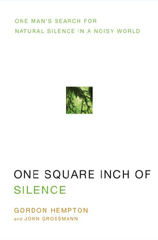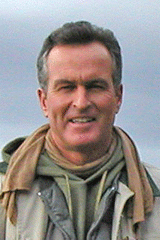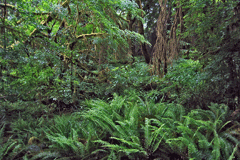In Search of Silence
Air Date: Week of April 3, 2009

Gordon Hempton has traveled the world in search of undisturbed natural sound. But as the audio ecologist describes in his new book, “One Square Inch of Silence; One Man’s Search for Natural Silence in a Noisy World,” it’s getting harder and harder to find pure natural sound. Hempton has launched a campaign to raise awareness about noise pollution, and tells Steve Curwood why silence matters.
Transcript
Gordon Hempton has dedicated his life to listening. As an acoustic ecologist, Mr. Hempton has captured audio landscapes on every continent except Antarctica, criss-crossing some of the most unbeaten paths on the globe with his recording equipment.

Author Gordon Hempton.
Gordon, please describe this place, this one square inch of silence for me?
HEMPTON: Yeah, so Olympic National Park is truly the listener’s Yosemite. It’s often called three parks in one because there are three areas that in another park would justify its entire existence. We have glacier-capped mountains, we have the temperate rain forest and we have a wilderness seashore. Now this is a world heritage site and also a biosphere reserve. It’s a wonderful place simply to be and to listen to the widest diversity of sounds of any national park in the 390 units that the National Park Service manages. But even more important to my ears is the fact that Olympic National Park has the longest duration of natural quiet than in any other national park.
CURWOOD: Tell me exactly where is this one square inch of silence.
HEMPTON: One square inch of silence is three point two miles up the Hoh River Trail, a trail that’s lined with the world’s tallest living creatures, moss covered, dug fir, western hemlock, western red cedar, sitka spruce. On a moss-covered log, I placed a stone given to me by the Quileute elder, David Fourlines.

The Hoh Rainforest, home of one square inch of silence. (Courtesy of Gordon Hempton)
CURWOOD: We have some of your sound from this place. Let’s play it right now.
[BIRDS SOUNDS, BUZZING, CROAKING]
CURWOOD: Well, actually, this is a pretty busy place, Gordon.
HEMPTON: Oh it can be. That’s definitely a springtime recording. It’s busy, lot of wildlife. We’re hearing a varied thrush there, a pacific chorus frog. They’re as busy communicating as we are. They have more important things to say, I think, than we have to say when we’re in a wilderness area. Our job is basically to listen. The frogs, the varied thrush, the winter wren, all these creatures are busy establishing their territories, hoping to find an additional mate. And you know, that brings up another question too, because not only does noise from outside sources impact our park experience, but it also impacts wildlife.
CURWOOD: Why do ecosystems need to be free of human noise?
HEMPTON: Steve, I think the whole earth is speaking. I hear it speaking. And so to ask me which ecosystem deserves to be heard, I think they all deserve to be heard. They all have something to say. Imagine this: all higher vertebrate species have the ability to hear, although not all species have the ability to see – hearing is vital for survival. And we don’t have ear lids, do we? In fact, no creature has ear lids, although we seem to have plenty of eyelids. It’s not only important that we hear, but it’s important that we listen. And I don’t think that we’re an exception to the animal kingdom.
So, if I would say what are my big, you know, hit list or first go, first see, first listen to the ecosystems, well, I would just jump right into the Amazon, because the earth is a solar powered jukebox. The more sun that hits the surface of the earth, basically, the louder it is. The Amazon, you know, that natural silence per se is really ripping, it’s a conversational voice. It is so ever-changing that you can identify the correct time of day just off the sound alone within five minutes.
And then jump up to Central America. I like Belize particularly.
And jump up further, it’s the songbirds of the southeast in Georgia. Of course, we’re in a economically developed country now, the United States, and with all that fossil fuel consumption, the solar powered jukebox is getting a little refigured because of all the transportation of this solar power.
And then jump up to the Canadian border here in eastern Washington, also western Washington, and there’s a poetics of space that’s just really remarkable, because, when you make a quiet recording, like the recording of coyotes singing, is this a recording of coyotes, or is this a recording of silence made audible by coyotes?
[COYOTES HOWLING]
HEMPTON: Listen closely, Steve, because there’s not one coyote, but there’re two. And they’re singing to each other after a long season of prosperity and to me it sounds like a celebration. But the point that I think that they really bring out is that if there were the slightest jet rumbling in the background, the experience of these coyotes would be entirely different.
[COYOTES HOWLING]
HEMPTON: Another recording, which I think will just really floor you, just like it floored me. I heard this – I read in John Muir’s journals – he describes snow melting into music. So, when you hear somebody say that or you read it yourself, you go “Oh, well what a poetic license. Isn’t that great.” But little might we guess, unless we actually do listen.
[SOUNDS OF SNOW MELTING, MARMOT CALL]
HEMPTON: That’s the Olympic marmot by the way, that’s an endangered species. It’s an endemic, just there at Olympic National Park.
[MARMOT CALL, SOUND OF SNOW MELTING]
HEMPTON: At this point you don’t know how hard it was for me not to just like stand up, wreck that recording because I just had to dance. I mean, yes, John Muir, thank you.
CURWOOD: Well I didn’t know Ma Nature was a jazz musician.
HEMPTON: Oh yeah, sure is. Are you a player yourself?
CURWOOD: [laughing] Nothing you’d want to have on the air
[LAUGHING]
HEMPTON: Okay.
CURWOOD: And, of course, people know John Muir as the naturalist who was the founder of the Sierra Club and inspired much of what we have in the way of national parks. And I gather you actually went to the place in Montgomery, Tennessee where Muir had his own epiphany about the environment. So tell me, Gordon, why was this one creek in Tennessee so important for you to visit and what was it that you found there?

CURWOOD: So when you get there, who’s there? Who do you meet?
HEMPTON: Well I find the creek, and I meet Randy. Randy is operating this large water truck for the National Coal Plant. And he sucks up water – he says that there’s no water, no coal – he says. And so he’s sucking up like a thirsty elephant, and then he drives off. But not until he gives me a suggestion on where I might find quiet.
CURWOOD: If you could read from that, it would be wonderful.
HEMPTON: “At Randy’s suggestion, I’m walking Roach’s Creek up the valley imagining I’m in Muir’s footsteps. Walking in the stream itself, I’m able to hear its changing voice. No two rocks are the same, no two flows are the same. At every step, a new combination, new notes. In a different time, Muir’s time for instance, I could have lost myself in these subtle variations, but with the distant din of National Coal Corporation mine number eleven in the background, it’s impossible to bend a calm ear. ‘Nothing more eloquent in nature than a mountain stream,’ Muir wrote in his journal very near to where I’m standing. What would he write today?”
CURWOOD: Gordon, we live in noisy culture, what’s to be done?
HEMPTON: Well our culture is noisy. What we can do today, number one, is include quiet in your life, simply include quiet in your life. Silence cannot be imagined, although a lot of people think so. Most people that are listening to this are recalling a quiet place that they have been in the last year. Well, I have to say, listen again.
CURWOOD: Tell us about an encounter or moment that just gave you hope for the future of the sound of nature in America, quiet in America.
HEMPTON: Every opportunity to hear nature undisturbed by motor noise inspires me, gives me hope. There are two places where that did happen on a ten thousand mile trip. And one in particular was Canyonlands, Canyonlands National Park, and many people may know this either personally or from the writings of Edward Abbey. And it’s there at night where you can look at the countless stars and simply be and breathe with the sighing of the wind – such a deep and peaceful sleep – and to be able to gaze out at – instead of trees that are hundreds of years old – you’re gazing out at a moonlit landscape where the rocks are millions of years old. This is a witness to being a miracle. How can we not gain inspiration? So, when I think about how are we going to quiet our culture, well for one thing, I don’t think there’s any choice. And the immense benefits from this – health for ourselves and also for wildlife – I believe we will. I believe we’ll quiet it. Beginning with Olympic National Park.
CURWOOD: Gordon Hempton’s book is ‘One Square Inch of Silence.” Thank you so much, Gordon,
HEMPTON: Thank you, Steve.
Links
Living on Earth wants to hear from you!
Living on Earth
62 Calef Highway, Suite 212
Lee, NH 03861
Telephone: 617-287-4121
E-mail: comments@loe.org
Newsletter [Click here]
Donate to Living on Earth!
Living on Earth is an independent media program and relies entirely on contributions from listeners and institutions supporting public service. Please donate now to preserve an independent environmental voice.
NewsletterLiving on Earth offers a weekly delivery of the show's rundown to your mailbox. Sign up for our newsletter today!
 Sailors For The Sea: Be the change you want to sea.
Sailors For The Sea: Be the change you want to sea.
 The Grantham Foundation for the Protection of the Environment: Committed to protecting and improving the health of the global environment.
The Grantham Foundation for the Protection of the Environment: Committed to protecting and improving the health of the global environment.
 Contribute to Living on Earth and receive, as our gift to you, an archival print of one of Mark Seth Lender's extraordinary wildlife photographs. Follow the link to see Mark's current collection of photographs.
Contribute to Living on Earth and receive, as our gift to you, an archival print of one of Mark Seth Lender's extraordinary wildlife photographs. Follow the link to see Mark's current collection of photographs.
 Buy a signed copy of Mark Seth Lender's book Smeagull the Seagull & support Living on Earth
Buy a signed copy of Mark Seth Lender's book Smeagull the Seagull & support Living on Earth

